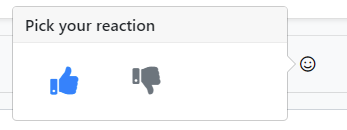Reaction System
CMS kit provides a reaction system to add reactions feature to any kind of resource, like blog posts or comments.
Reaction component allows users to react to your content via pre-defined icons/emojis. Here how the reactions component may looks like:
You can also customize the reaction icons shown in the reaction component.
Enabling the Reaction Feature
By default, CMS Kit features are disabled. Therefore, you need to enable the features you want, before starting to use it. You can use the Global Feature system to enable/disable CMS Kit features on development time. Alternatively, you can use the ABP Framework's Feature System to disable a CMS Kit feature on runtime.
Check the "How to Install" section of the CMS Kit Module documentation to see how to enable/disable CMS Kit features on development time.
Options
Reaction system provides a mechanism to group reactions by entity types. For example, if you want to use the reaction system for products, you need to define an entity type named Product, and then add reactions under the defined entity type.
CmsKitReactionOptions can be configured in the domain layer, in the ConfigureServices method of your module. Example:
Configure<CmsKitReactionOptions>(options =>
{
options.EntityTypes.Add(
new ReactionEntityTypeDefinition(
"Product",
reactions: new[]
{
new ReactionDefinition(StandardReactions.Smile),
new ReactionDefinition(StandardReactions.ThumbsUp),
new ReactionDefinition(StandardReactions.ThumbsDown),
new ReactionDefinition(StandardReactions.Confused),
new ReactionDefinition(StandardReactions.Eyes),
new ReactionDefinition(StandardReactions.Heart)
}));
});
If you're using the Comment or Blogging features, the ABP framework defines predefined reactions for these features automatically.
CmsKitReactionOptions properties:
EntityTypes: List of defined entity types (CmsKitReactionOptions) in the reaction system.
ReactionEntityTypeDefinition properties:
EntityType: Name of the entity type.Reactions: List of defined reactions (ReactionDefinition) in the entity type.
The Reactions Widget
The reaction system provides a reaction widget to allow users to send reactions to resources. You can place the widget on a page like below:
@await Component.InvokeAsync(typeof(ReactionSelectionViewComponent), new
{
entityType = "Product",
entityId = "..."
})
entityType was explained in the previous section. entityId should be the unique id of the product, in this example. If you have a Product entity, you can use its Id here.
Internals
Domain Layer
Aggregates
This module follows the Entity Best Practices & Conventions guide.
UserReaction
A user reaction represents a given reaction from a user.
UserReaction(aggregate root): Represents a given reaction in the system.
Repositories
This module follows the Repository Best Practices & Conventions guide.
Following custom repositories are defined for this feature:
IUserReactionRepository
Domain services
This module follows the Domain Services Best Practices & Conventions guide.
Reaction Manager
ReactionManager is used to perform some operations for the UserReaction aggregate root.
Application layer
Application services
ReactionPublicAppService(implementsIReactionPublicAppService): Implements the use cases of reaction system.
Database providers
Common
Table / collection prefix & schema
All tables/collections use the Cms prefix by default. Set static properties on the CmsKitDbProperties class if you need to change the table prefix or set a schema name (if supported by your database provider).
Connection string
This module uses CmsKit for the connection string name. If you don't define a connection string with this name, it fallbacks to the Default connection string.
See the connection strings documentation for details.
Entity Framework Core
Tables
- CmsUserReactions
MongoDB
Collections
- CmsUserReactions


